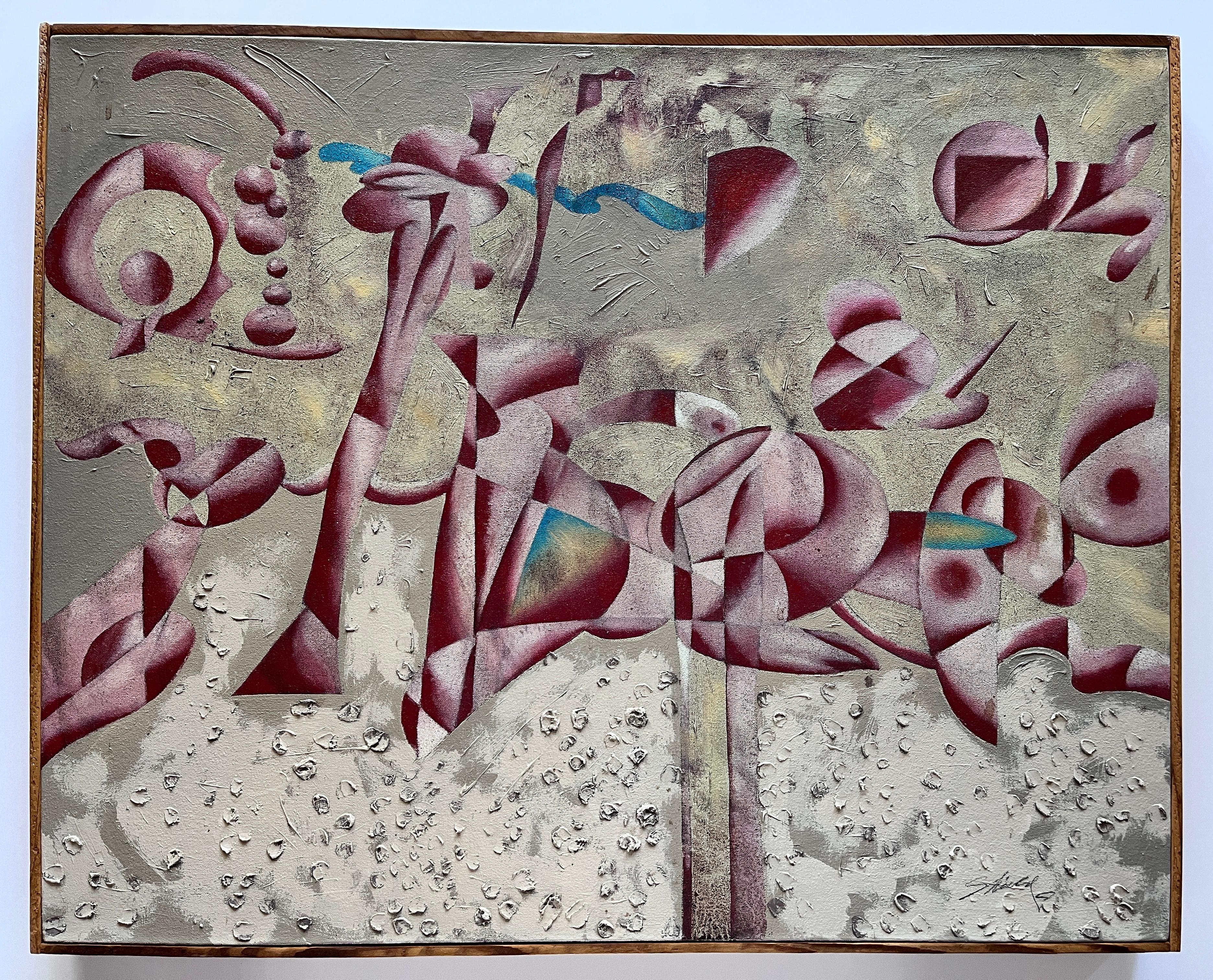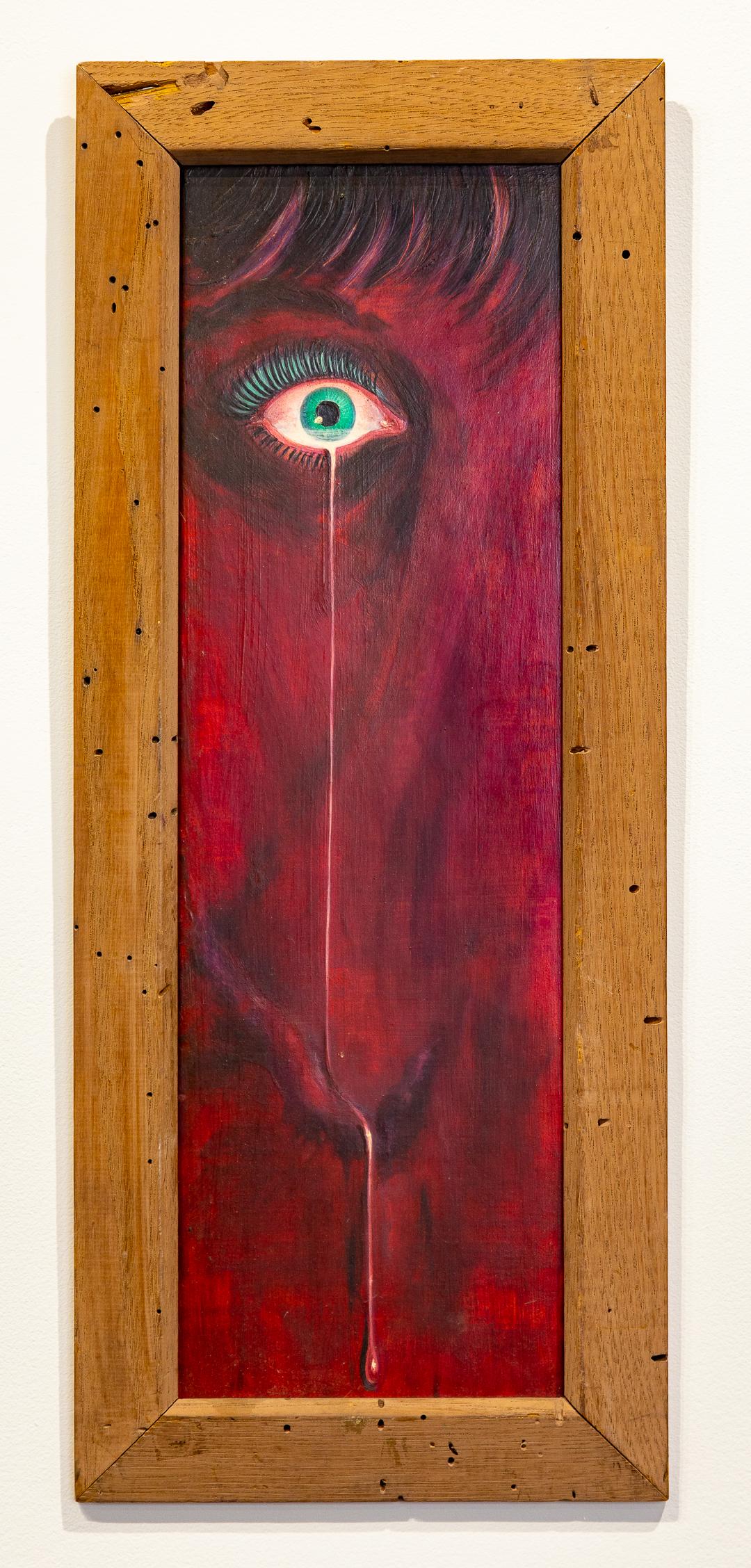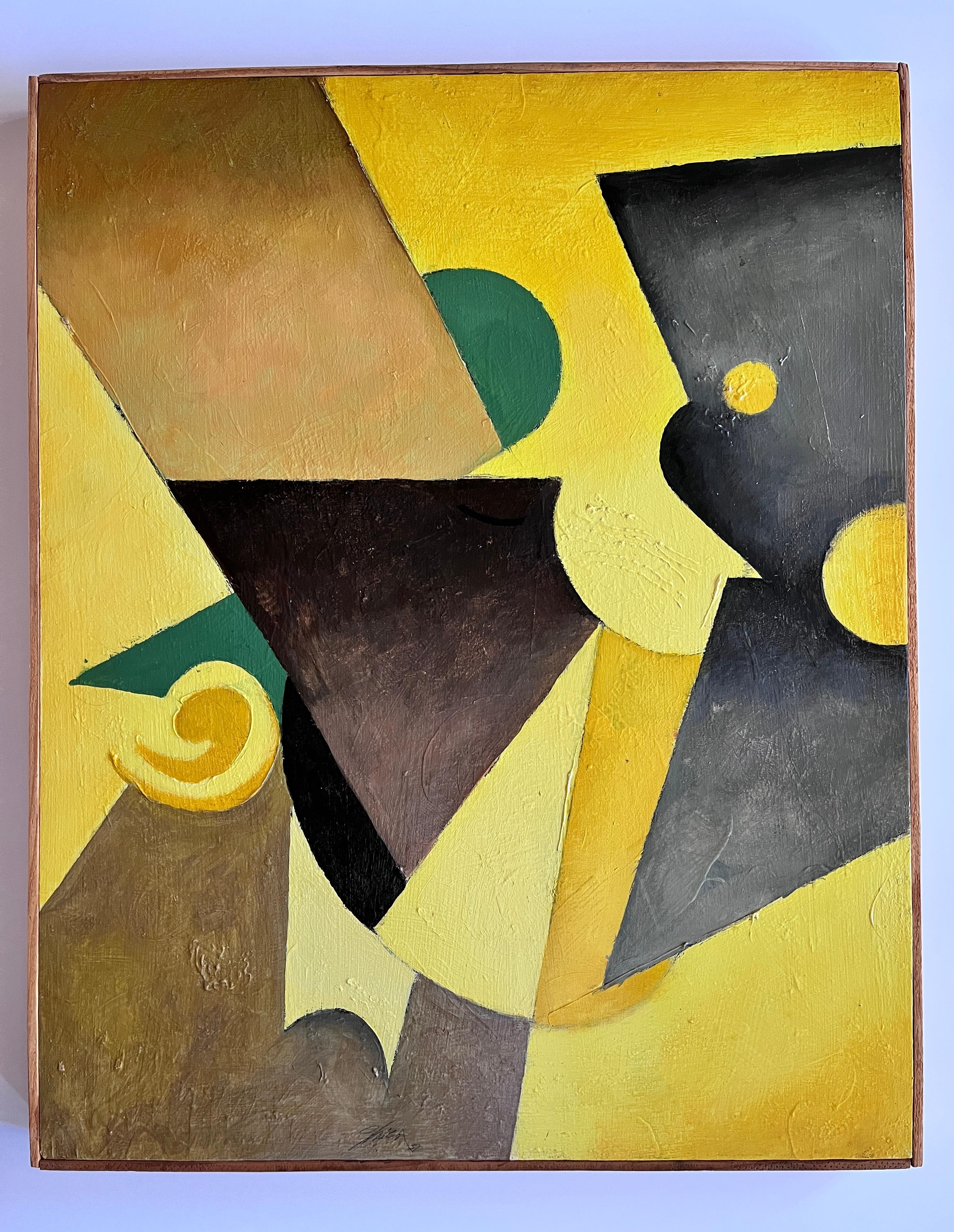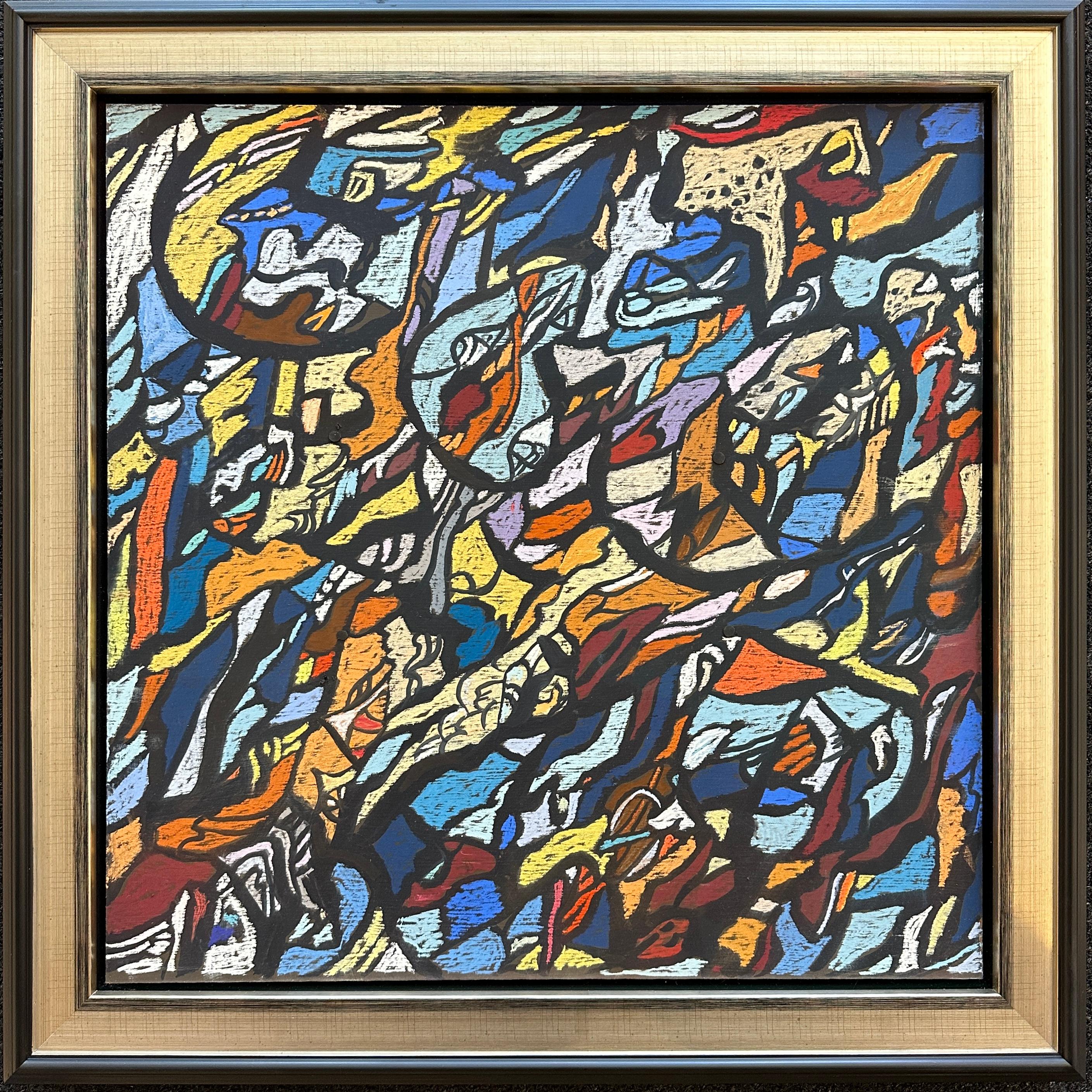
Textured Abstract in Neutral Tones, Oil Painting, Circa 1950s
View Similar Items
1 of 5
Calvin AndersonTextured Abstract in Neutral Tones, Oil Painting, Circa 1950sCirca 1950s
Circa 1950s
About the Item
- Creator:Calvin Anderson (1925)
- Creation Year:Circa 1950s
- Dimensions:Height: 24.75 in (62.87 cm)Width: 23.75 in (60.33 cm)Depth: 1 in (2.54 cm)
- Medium:
- Movement & Style:
- Period:
- Condition:General vintage wear.
- Gallery Location:San Francisco, CA
- Reference Number:Seller: 965941stDibs: LU29822930121
You May Also Like
- Modern Abstract Painting by Ted GilienBy Ted GilienLocated in Long Island City, NYArtist: Ted Gilien, American (1914 - 1967) Title: Untitled Year: circa 1960 Medium: Oil on Masonite, signed l.l. Size: 24 x 32 inches [60.96 x 81.28 cm]Category
1960s American Modern Abstract Paintings
MaterialsMasonite, Oil
- Double Sided Painting (Still Life and Abstract) by William Littlefield 1950-1954Located in Long Island City, NYArtist: William Littlefield, American (1902 - 1969) Title: Still Life and Abstract Year: 1950 & 1954 Medium: Double-Sided Oil on Masonite, signed and dated both sides Size: 22 x 28 i...Category
1950s American Modern Still-life Paintings
MaterialsMasonite, Oil
- "Animal" Abstract Oil on Canvas Award Winning Illustrator Bill ShieldsLocated in Arp, TXBill Shields "Pink Abstract" 1970's Oil on canvas Artist's wood frame 30"x2"x24" Signed in paint lower right Excellent Condition - Minor wear consistent with age and history. CV EDUCATION: Chicago Academy Of Fine Art San Antonio Art Institute MAJOR FIELDS OF PROFESSIONAL ENDEAVOR: Freelance graphic design and illustration Instructor of painting and illustration Landscape, figurative and abstract painting ART RELATED EMPLOYMENT: (Professor of Art) California College of Arts and Crafts, Oakland, CA Academy of Art College, San Francisco, CA San Francisco Art Institute San Jose State University AWARDS FOR ILLUSTRATION, Gold Medals: New York Society of Illustrators Los Angeles Society of Illustrators San Francisco Society of Illustrators Dallas-Fort Worth Art Director's Club Houston Artist's Guild BIBLIOGRAPHY: Feature articles in: American Artist, Communication Arts, Print, North Light. Architectural design featured in: Better Homes and Gardens, American Home, Sunset Magazine, Architectural Digest. ILLUSTRATION CLIENTS: Oil Companies: Champlin Oil Company, Mobil Oil Company, Continental Oil Company, Standard Oil Company, Humble Oil and Refining Company. Industrial: Hughes Tool Company, General Electric, United States Steel, Phelps Dodge, Sylvania Television, Texas Gulf Sulphur, Litton Industries, Houston Lighting and Power Company, International Business Machines. Institutional: National Aeronautics and Space Administration, United States Air Force, United States Department of the Interior, American Petroleum Institute, New York Stock Exchange, National Broadcasting Company, American Iron and Steel Institute, CBS Broadcasting Company, Vanguard Recording Company, Diners Club, Stanford Research Institute, Victoria Station, Neiman Marcus, Bank of America, Automobile Club of Southern California, Airlines: TWA, British West Indies Airlines, Pan American Airlines...Category
Mid-20th Century American Modern Abstract Paintings
MaterialsMasonite, Oil
- St. Atomic oil and tempera painting by Julio de DiegoBy Julio de DiegoLocated in Hudson, NYJulio De Diego’s Atomic Series paintings made an extraordinary statement regarding the shock and fear that accompanied the dawn of the nuclear age. In the artist’s own words, “Scientists were working secretly to develop formidable powers taken from the mysterious depths of the earth - with the power to make the earth useless! Then, the EXPLOSION! . . . we entered the Atomic Age, and from there the neo-Atomic war begins. Explosions fell everywhere and man kept on fighting, discovering he could fight without flesh.” To execute these works, De Diego developed a technique of using tempera underpainting before applying layer upon layer of pigmented oil glazes. The result is paintings with surfaces which were described as “bonelike” in quality. The forms seem to float freely, creating a three-dimensional visual effect. In the 1954 book The Modern Renaissance in American Art, author Ralph Pearson summarizes the series as “a fantastic interpretation of a weighty theme. Perhaps it is well to let fantasy and irony appear to lighten the devastating impact. By inverse action, they may in fact increase its weight.” Exhibited 1950 University of Illinois at Urbana "Contemporary American Painting" 1964 Marion Koogler McNay Art Institute, San Antonio, Texas This work retains its original frame which measures 54" x 36" x 2". About this artist: Julio De Diego crafted a formidable persona within the artistic developments and political struggles of his time. The artist characterized his own work as “lyrical,” explaining, “through the years, the surrealists, the social-conscious painters and the others tried to adopt me, but I went my own way, good, bad or indifferent.” [1] His independence manifested early in life when de Diego left his parent’s home in Madrid, Spain, in adolescence following his father’s attempts to curtail his artistic aspirations. At the age of fifteen he held his first exhibition, set up within a gambling casino. He managed to acquire an apprenticeship in a studio producing scenery for Madrid’s operas, but moved from behind the curtains to the stage, trying his hand at acting and performing as an extra in the Ballet Russes’ Petrouchka with Nijinsky. He spent several years in the Spanish army, including a six-month stretch in the Rif War of 1920 in Northern Africa. His artistic career pushed ahead as he set off for Paris and became familiar with modernism’s forays into abstraction, surrealism, and cubism. The artist arrived in the U.S. in 1924 and settled in Chicago two years later. He established himself with a commission for the decoration of two chapels in St. Gregory’s Church. He also worked in fashion illustration, designed magazine covers and developed a popular laundry bag for the Hotel Sherman. De Diego began exhibiting through the Art Institute of Chicago in 1929, and participated in the annual Chicago Artists Exhibitions, Annual American Exhibitions, and International Water Color Exhibitions. He held a solo exhibition at the Art Institute of Chicago in the summer of 1935. Though the artist’s career was advancing, his family life had deteriorated. In 1932 his first marriage dissolved, and the couple’s young daughter Kiriki was sent to live with friend Paul Hoffman. De Diego continued to develop his artistic vocabulary with a growing interest in Mexican art. He traveled throughout the country acquainting himself with the works of muralists such as Carlos Merida, and also began a collection of small native artifacts...Category
1940s American Modern Abstract Paintings
MaterialsMasonite, Oil, Tempera
- The Magician oil and tempera painting by Julio de DiegoBy Julio de DiegoLocated in Hudson, NYJulio De Diego’s Atomic Series paintings made an extraordinary statement regarding the shock and fear that accompanied the dawn of the nuclear age. In the artist’s own words, “Scientists were working secretly to develop formidable powers taken from the mysterious depths of the earth - with the power to make the earth useless! Then, the EXPLOSION! . . . we entered the Atomic Age, and from there the neo-Atomic war begins. Explosions fell everywhere and man kept on fighting, discovering he could fight without flesh.” To execute these works, De Diego developed a technique of using tempera underpainting before applying layer upon layer of pigmented oil glazes. The result is paintings with surfaces which were described as “bonelike” in quality. The forms seem to float freely, creating a three-dimensional visual effect. In the 1954 book The Modern Renaissance in American Art, author Ralph Pearson summarizes the series as “a fantastic interpretation of a weighty theme. Perhaps it is well to let fantasy and irony appear to lighten the devastating impact. By inverse action, they may in fact increase its weight.” Exhibited 1964 Marion Koogler McNay Art Institute, San Antonio, Texas This work retains its original frame which measures 54" x 42" x 2" About this artist: Julio De Diego crafted a formidable persona within the artistic developments and political struggles of his time. The artist characterized his own work as “lyrical,” explaining, “through the years, the surrealists, the social-conscious painters and the others tried to adopt me, but I went my own way, good, bad or indifferent.” [1] His independence manifested early in life when de Diego left his parent’s home in Madrid, Spain, in adolescence following his father’s attempts to curtail his artistic aspirations. At the age of fifteen he held his first exhibition, set up within a gambling casino. He managed to acquire an apprenticeship in a studio producing scenery for Madrid’s operas, but moved from behind the curtains to the stage, trying his hand at acting and performing as an extra in the Ballet Russes’ Petrouchka with Nijinsky. He spent several years in the Spanish army, including a six-month stretch in the Rif War of 1920 in Northern Africa. His artistic career pushed ahead as he set off for Paris and became familiar with modernism’s forays into abstraction, surrealism, and cubism. The artist arrived in the U.S. in 1924 and settled in Chicago two years later. He established himself with a commission for the decoration of two chapels in St. Gregory’s Church. He also worked in fashion illustration, designed magazine covers and developed a popular laundry bag for the Hotel Sherman. De Diego began exhibiting through the Art Institute of Chicago in 1929, and participated in the annual Chicago Artists Exhibitions, Annual American Exhibitions, and International Water Color Exhibitions. He held a solo exhibition at the Art Institute of Chicago in the summer of 1935. Though the artist’s career was advancing, his family life had deteriorated. In 1932 his first marriage dissolved, and the couple’s young daughter Kiriki was sent to live with friend Paul Hoffman. De Diego continued to develop his artistic vocabulary with a growing interest in Mexican art. He traveled throughout the country acquainting himself with the works of muralists such as Carlos Merida, and also began a collection of small native artifacts...Category
1940s American Modern Abstract Paintings
MaterialsMasonite, Oil, Tempera
- Inevitable Day – Birth of the Atom oil and tempera painting by Julio De DiegoBy Julio de DiegoLocated in Hudson, NYJulio De Diego’s Atomic Series paintings made an extraordinary statement regarding the shock and fear that accompanied the dawn of the nuclear age. In the artist’s own words, “Scientists were working secretly to develop formidable powers taken from the mysterious depths of the earth - with the power to make the earth useless! Then, the EXPLOSION! . . . we entered the Atomic Age, and from there the neo-Atomic war begins. Explosions fell everywhere and man kept on fighting, discovering he could fight without flesh.” To execute these works, De Diego developed a technique of using tempera underpainting before applying layer upon layer of pigmented oil glazes. The result is paintings with surfaces which were described as “bonelike” in quality. The forms seem to float freely, creating a three-dimensional visual effect. In the 1954 book The Modern Renaissance in American Art, author Ralph Pearson summarizes the series as “a fantastic interpretation of a weighty theme. Perhaps it is well to let fantasy and irony appear to lighten the devastating impact. By inverse action, they may in fact increase its weight.” Bibliography Art in America, April 1951, p.78 About this artists: Julio De Diego crafted a formidable persona within the artistic developments and political struggles of his time. The artist characterized his own work as “lyrical,” explaining, “through the years, the surrealists, the social-conscious painters and the others tried to adopt me, but I went my own way, good, bad or indifferent.” [1] His independence manifested early in life when de Diego left his parent’s home in Madrid, Spain, in adolescence following his father’s attempts to curtail his artistic aspirations. At the age of fifteen he held his first exhibition, set up within a gambling casino. He managed to acquire an apprenticeship in a studio producing scenery for Madrid’s operas, but moved from behind the curtains to the stage, trying his hand at acting and performing as an extra in the Ballet Russes’ Petrouchka with Nijinsky. He spent several years in the Spanish army, including a six-month stretch in the Rif War of 1920 in Northern Africa. His artistic career pushed ahead as he set off for Paris and became familiar with modernism’s forays into abstraction, surrealism, and cubism. The artist arrived in the U.S. in 1924 and settled in Chicago two years later. He established himself with a commission for the decoration of two chapels in St. Gregory’s Church. He also worked in fashion illustration, designed magazine covers and developed a popular laundry bag for the Hotel Sherman. De Diego began exhibiting through the Art Institute of Chicago in 1929, and participated in the annual Chicago Artists Exhibitions, Annual American Exhibitions, and International Water Color Exhibitions. He held a solo exhibition at the Art Institute of Chicago in the summer of 1935. Though the artist’s career was advancing, his family life had deteriorated. In 1932 his first marriage dissolved, and the couple’s young daughter Kiriki was sent to live with friend Paul Hoffman. De Diego continued to develop his artistic vocabulary with a growing interest in Mexican art. He traveled throughout the country acquainting himself with the works of muralists such as Carlos Merida, and also began a collection of small native artifacts...Category
1940s American Modern Abstract Paintings
MaterialsMasonite, Oil, Tempera









